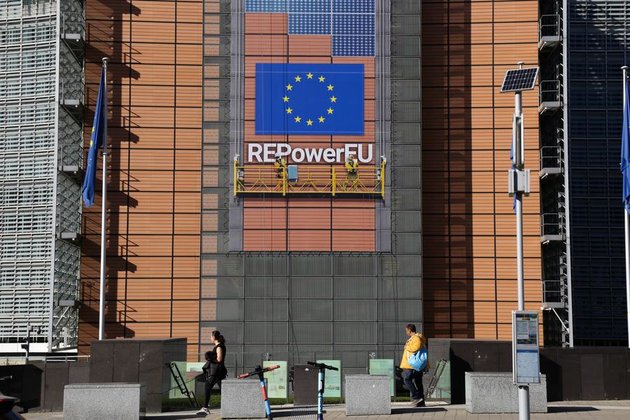World Insights: EU money fattens U.S. arms industry, independent defense stays in dream


Europe has stayed under the U.S. umbrella of protection for decades, which has created a weakening EU defense industry and many loyal consumers of U.S. weapons.
BRUSSELS, Sept. 13 (Xinhua) — A recent report released by the European Commission revealed that between June 2022 and June 2023, about two-thirds of the European Union (EU)’s defense spending was diverted to U.S. companies.
By citing figures and comparing the U.S. and European defense industries, former Italian Prime Minister and former European Central Bank chief Mario Draghi, the drafter of the report, highlighted the urgency for the EU to build up more self-reliant defense capability.
Draghi’s report rings an alarm among EU leaders. Europe has stayed under the U.S. umbrella of protection for decades, which has created a weakening EU defense industry and many loyal consumers of U.S. weapons. The question remains whether the EU has the ambition and ability to grow as a more able and equal U.S. ally in terms of defense ability.
HOW EUROPE FEEDS U.S. DEFENSE INDUSTRY
According to Draghi’s report on EU competitiveness, 78 percent of the EU’s defense procurement spending from June 2022 to June 2023 went to non-EU suppliers, with 63 percent based in the United States.
“Europe is wasting its common resources. We have large collective spending power, but we dilute it across multiple different national and EU instruments,” said the report.
Although European arms companies also operate in small domestic markets, EU countries don’t coordinate on procurement and 80 percent of it depend on international suppliers, largely from the United States, it added.
In 2022, less than one-fifth of Europe’s defense equipment procurement spending was done collaboratively among EU member states.
The Netherlands, Germany, Poland, Romania, Belgium, Denmark, and the Czech Republic all reportedly plan to purchase F-35 stealth fighters from U.S. company Lockheed Martin. Additionally, Poland has spent billions of U.S. dollars procuring U.S.-made Apache attack helicopters.
Across the pond, arms sales have brought great fortune to the U.S. military-industrial complex. A Wall Street Journal article in February audaciously titled “How War in Europe Boosts the U.S. Economy” cited the U.S. State Department as saying that in the year through September 2023, America made more than 80 billion dollars in major arms deals, of which about 50 billion dollars from European allies — more than five times the historical norm.

European allies’ misfortune is translated into U.S. stock market euphoria. U.S. financial advisory website The Motley Fool, for example, has recommended investors prioritize defense stocks this year, as these stocks offer “substantial and stable” returns in the long run. Among their six top investment picks, the top five are the largest global defense contractors — Lockheed Martin, Boeing, Northrop Grumman, General Dynamics, and Raytheon Technologies, all U.S. companies.
WHY EU MEMBERS FAVOR U.S. ARMS
Draghi’s report has analyzed reasons why EU member states favor U.S. arms manufacturers, even when a European equivalent exists, or could be rapidly made available by the European defense industry. The reasons include EU members’ poor knowledge of what the EU defense industry can offer, U.S. products’ availability and advantage in quality and price, and long-term ties with the U.S. military apparatus.
The U.S. defense industry’s capability and reliability of their products come from tests of real combat and military actions launched by U.S. administrations across the world in recent years.
State support and large sales result in large-scale production, which brings down the prices. Meanwhile, the U.S. military research and development investment is substantial, which maintains the advancement of its products and also provides a price advantage. Those elements form a self-reinforcing cycle for the U.S. defense industry.
Take fighter jets for example. Europe has produced fewer than 900 units of Eurofighter Typhoon, manufactured by a consortium of Airbus, BAE Systems and Leonardo, and France-made Rafale in total, while the U.S. F-35 has garnered 3,500 orders across the world with lower costs.

Meanwhile, many European countries, especially NATO members, prefer U.S. weapons to strengthen political and military ties with Washington.
Jian Junbo, deputy director of the Center for China-Europe Relations of the Institute of International Studies at Fudan University, said the absence of a common defense system in Europe is at the root of internal competition and a lack of common standards for similar equipment.
WHERE EU DEFENSE WILL GO
Citing geopolitical tensions, the EU report stressed the significance of refocusing the EU’s collective efforts on closing the innovation gap with the United States. Building a powerful and independent defense capability has become an obvious EU ambition, and Draghi underlined a solution of “a better-directed stream of cash.”
Aiming to mobilize both public and private investment, the report urged EU members to start to facilitate “massive investment needs unseen for half a century in Europe” to boost innovation, restore lost capabilities owing to decades of underinvestment, and replenish depleted stocks.
However, old habits of member states and new political challenges facing the EU both make the bloc’s defense ambition a long shot.
Currently, all EU members’ combined defense expenditure accounts for only approximately one-third of the U.S. Only 10 out of 27 EU member states spend more than or equal to 2 percent of GDP in line with NATO commitments.
The European defense industry, according to Draghi’s report, lacks scale and standardization and doesn’t have a full supply chain.
The report argued that “industrial policies, if not designed and executed at EU level, would destroy the single market and penalize the countries with less budgetary margins.” However, the fact that France and Germany are struggling with domestic political uncertainties, while Italy was isolated on EU level would make it difficult to find common ground on the issue, Lucrezia Reichlin, an economist at the London Business School, wrote on Italian newspaper Il Corriere della Sera.
In Jian’s view, standardizing weapon systems and promoting joint research and development will benefit the European defense industry and help retain more defense spending within the EU market in the long run.
According to sources such as the European Security & Defence magazine, European countries have already taken several collaborative defense initiatives to enhance their collective capabilities and strategic autonomy, like the European Defence Fund, Permanent Structured Cooperation, and the European Defence Industrial Development Programme.
“What Draghi has posed is an existential challenge,” analyst Andrea Bonanni wrote on Italy’s main daily, La Repubblica, but also raised the question: “Will Europe be able to take it up?”



